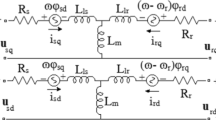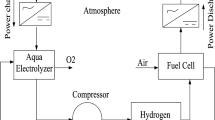Abstract
This paper proposes a variable speed control algorithm for a grid connected doubly-fed induction generator system. The main objective is to track the maximum power point by using an adaptive hill climb searching (HCS) technique based on fuzzy logic controller (FLC), and compare it with the conventional optimal torque control method for large inertia wind turbines. The role of the FLC is to adapt the step-size of the HCS method according to the operating point. The control system has two sub-systems for the rotor side and the grid side converters (RSC, GSC). Active and reactive power control of the back-to-back converters has been achieved indirectly by controlling q-axis and d-axis current components. The main function of the RSC controllers is to track the maximum power through controlling the rotational speed of the wind turbine. The GSC controls the DC-link voltage, and guarantees unity power factor between the GSC and the grid regardless of the magnitude and direction of the slip power. The proposed system is developed and tested in MATLAB/SimPowerSystem environment.










Similar content being viewed by others
References
Abdullah MA, Yatim AHM, Tan CW (2011) A study of maximum power point tracking algorithms for wind energy system. In: First IEEE conference on clean energy and technology, pp 321–326
Abdullah MA, Yatim AHM, Tan CW, Saidur R (2012) A review of maximum power point tracking algorithms for wind energy systems. Renew Sustain Energy Rev 16:3220–3227
Abo-Khalil AG, Lee DC, Seok JK (2004) Variable speed wind power generation system based on fuzzy logic control for maximum power output tracking. In: 35th annual IEEE power electronics specialists conference, PESC, Aachen, Germany, vol 3, pp 2039–2043
Akhmatov V (2002) Modelling of variable-speed wind turbines with doubly-fed induction generators in short term stability investigations. In: International workshop on transmission networks for offshore wind farms, Stockholm, Sweden, p 23
Bianchi F, De Battista H, Mantz R (2006) Wind turbine control systems: principles, modelling and gain-scheduling design advances in industrial control. Lavoisier, Paris
Boukhezzar B, Siguerdidjane H (2011) Nonlinear control of a variable wind turbine using a two mass model. IEEE Trans Energy Convers 26(1):149–162
Chedid R, Mrad F, Basma M (1999) Intelligent control of a class of wind energy conversion systems. IEEE Trans Energy Convers 14:1597–1604
Ching-Tsai P, Yu-Ling J (2010) A novel sensorless MPPT controller for a high-efficiency micro-scale wind power generation system. IEEE Trans Energy Convers 25:207–216
Eltamaly AM, Farh HM (2013) Maximum power extraction from wind energy system based on fuzzy logic control. Electr Power Syst Res 97:144–150
Fadaeinedjad R, Moallem M, Moschopoulos G (2008) Simulation of a wind turbine with doubly fed induction generator by FAST and Simulink. IEEE Trans Energy Convers 23(2):690–700
Feng X, Jianzhong Z, Ming C (2011) Analysis of double objectives control for wind power generation system with frequency separation. In: 4th international conference on electric utility deregulation and restructuring and power technologies (DRPT), pp 1366–1371
Hong MK, Lee HH (2010) Adaptive maximum power point tracking algorithm for variable speed wind power systems. In: International conference on life system modeling and intelligent computing, and international conference on intelligent computing for sustainable energy and environment. Part I. Wuxi, China, pp 380–388
Hua ACC, Cheng BCH (2010) Design and implementation of power converters for wind energy conversion system. In: International power electronics conference (IPEC), pp 323–328
Hui J, Bakhshai A (2008) A new adaptive control algorithm for maximum power point tracking for wind energy conversion systems. In: IEEE power electronics specialists conference (PESC), pp 4003–4007
Iof F, Hansen AD, Sorensen P, Blaabjerg F (2004) Wind turbine blockset in MATLAB/simulink, general overview and description of the model. Aalborg University, Aalborg
Kazmi SMR, Goto H, Hai-Jiao G, Ichinokura O (2007) Maximum power point tracking control and voltage regulation of a DC grid-tied wind energy conversion system based on a novel permanent magnet reluctance generator. In: International conference on electrical machines and systems (ICEMS), pp 1533–1538
Kazmi SMR, Goto H, Hai-Jiao G, Ichinokura O (2010) Review and critical analysis of the research papers published till date on maximum power point tracking in wind energy conversion system. In: IEEE energy conversion congress and exposition (ECCE), pp 4075–4082
Kazmi SMR, Goto H, Hai-Jiao G, Ichinokura O (2011) A novel algorithm for fast and efficient speed-sensorless maximum power point tracking in wind energy conversion systems. IEEE Trans Ind Electron 58:29–36
Kesraoui M, Korichi N, Belkadi A (2011) Maximum power point tracker of wind energy conversion system. Renew Energy 36:2655–2662
Koutroulis E, Kalaitzakis K (2006) Design of a maximum power tracking system for wind-energy-conversion applications. IEEE Trans Ind Electron 53(2):486–494
Ledesma P, Usaola J (2005) Doubly fed induction generator model for transient stability analysis. IEEE Trans Energy Convers 20(2):388–397
Li H, Shi KL, McLaren PG (2005) Neural-network-based sensorless maximum wind energy capture with compensated power coefficient. IEEE Trans Ind Appl 41(6):1548–1556
Lopez J, Sanchis P, Roboam X, Marroyo L (2007) Dynamic behavior of the doubly fed induction generator during three-phase voltage dips. IEEE Trans Energy Convers 22(3):709–717
Muller S, Deicke M, De Doncker RW (2002) Doubly-fed induction generator systems for wind turbines. IEEE Ind Appl Mag 3(1):26–33
Neammanee B, Sirisumranukul S, Chatratana S (2006) Control performance analysis of feed forward and maximum peak power tracking for small-and medium sized fixed pitch wind turbines. In: 9th international conference on control, automation, robotics and vision (ICARCV’06), pp 1–7
Patsios C, Chaniotis A, Kladas A (2008) A hybrid maximum power point tracking system for grid-connected variable speed wind-generators. In: IEEE power electronics specialists conference (PESC), pp 1749–1754
Pena R, Clare JC, Asher GM (1996) Doubly-fed induction generator using back-to-back PWM converters and its application to variable-speed wind-energy generation. IEE Proc Electr Power Appl 143(3):231–241
Raju AB, Fernandes BG, Chatterjee K (2004) A UPF power conditioner with maximum power point tracker for grid connected variable speed wind energy conversion system. In: First international conference on PESA, Bombay, India, pp 107–112
Slootweg JG, de Haan SWH, Polinder H, Kling WL (2003) General model for representing variable speed wind turbines in power system dynamic simulation. IEEE Trans Power Syst 18(1):144–151
Thiringer T, Linders J (1993) Control by variable rotor speed of a fixed-pitch wind turbine operating in a wide speed range. IEEE Trans Energy Convers 8(3):520–526
Wang Q, Chang L (2004) An intelligent maximum power extraction algorithm for inverter-based variable speed wind turbine systems. IEEE Trans Power Electron 19(5):1242–1249
Zou Y, Elbuluk M, Sozer Y (2010) A complete modeling and simulation of induction generator wind power systems. In: IEEE industry applications society annual meeting (IAS), pp 1–8
Author information
Authors and Affiliations
Corresponding author
Rights and permissions
About this article
Cite this article
Dida, A., Attous, D.B. Adaptive hill-climb searching method for MPPT algorithm based DFIG system using fuzzy logic controller. Int J Syst Assur Eng Manag 8 (Suppl 1), 424–434 (2017). https://doi.org/10.1007/s13198-015-0392-0
Received:
Revised:
Published:
Issue Date:
DOI: https://doi.org/10.1007/s13198-015-0392-0




